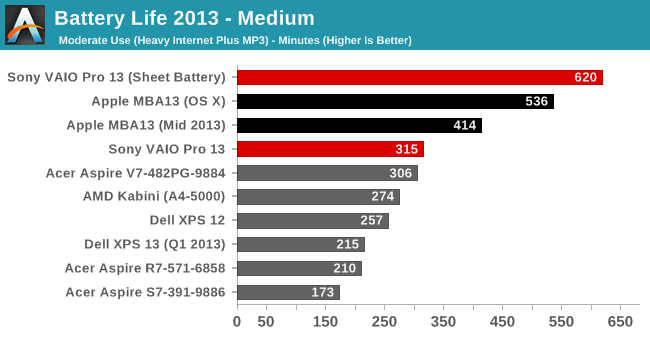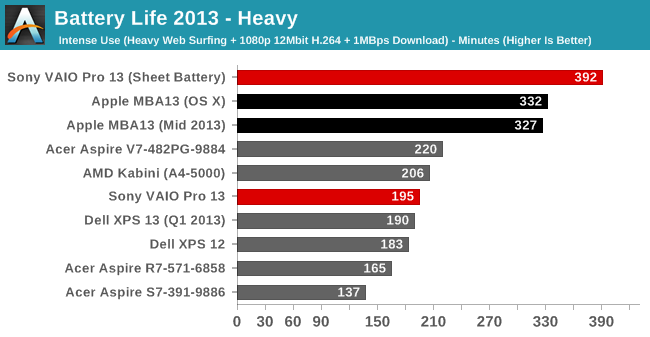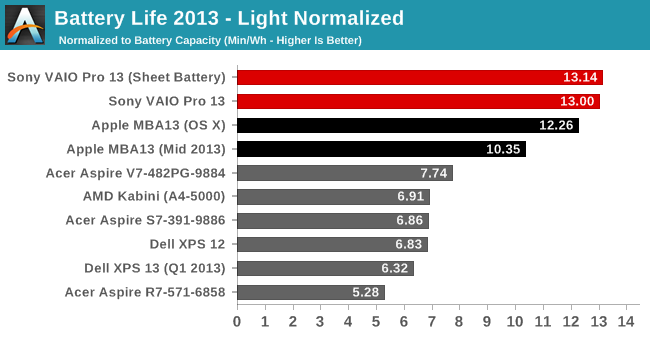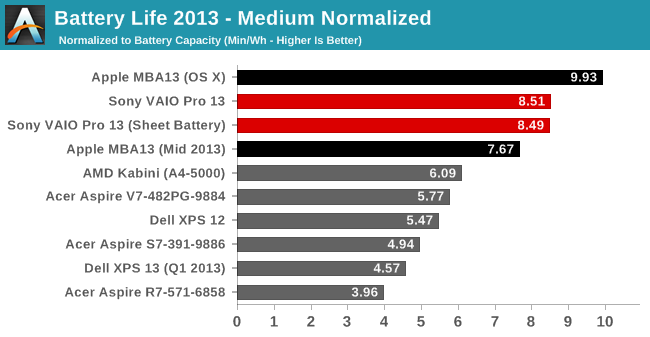Sony VAIO Pro 13: Exceptionally Portable
by Jarred Walton on October 16, 2013 12:00 AM ESTSony VAIO Pro 13: Excellent Battery Life
If the performance in applications wasn't particularly impressive, where Sony positively shines is in their battery life. We have our standard Light, Medium, and Heavy battery life tests, and even the Light test is reasonably demanding (loading four web pages every 60 seconds). We also run the LCD at 200 nits (87% on the VAIO Pro 13), so turning down the brightness will only improve these results.
This is also one of the tests where we can make cross-OS comparisons to Apple's MacBook Air 13. We've seen in the past that OS X gets substantially better battery life with MacBooks than Windows, but we're at least able to run the same workloads so the tests are more or less “fair”. Anand ran the MBA13 under both Windows 8 and OS X, and we've included both results in the charts below. For the VAIO Pro 13, we likewise have results using just the integrated 37Wh battery as well as with the extra sheet battery.






In terms of pure battery life numbers, with the extra battery the Sony VAIO Pro 13 comes in at the top of our charts, but even without the doubling of capacity it does well. In raw battery life, it trails the Haswell-equipped MacBook Air 13 (particularly when the latter is running OS X), and in the Heavy test it also falls behind the Acer V7 and the AMD Kabini prototype. That's only part of the story, however, as the integrated battery is pretty small compared to many of the other laptops in our charts.
Look at the normalized battery life and the VAIO Pro 13 is quite a ways ahead of any other (Windows) contender in the Light and Medium loads. Apple still does better in heavy loads, indicating that Apple is either more aggressive in getting down to lower power C-states, and in OS X Apple also posts an impressive result in our Medium workload. The Heavy load tends to not allow the CPU to relax much (It averages out to around a 20-30% CPU load throughout the test), so it's not too surprising that the MBA13 results are a lot closer to their Win8 results in that particular test.
Adding the sheet battery basically doubles battery life, which puts Sony way ahead of any other laptop we've tested in recent years (though it doesn't change the normalized results). It was almost painful to test battery life, simply because it took so long for the battery to go dead. With the Light dual-battery testing, I started the test, went to bed, came back the next morning and the combined battery charge was still around 50%. If you need even more battery life, you could purchase additional external batteries and swap them quite easily with no downtime, and since Sony has the laptop drain the sheet battery first, you don't need to worry about the integrated battery unexpectedly running out of power.
However you want to look at it, the Sony VAIO Pro 13 delivers on the battery life front. This is how every Haswell laptop should behave, at a minimum. Sadly, we have plenty of examples where this level of power optimization is clearly not in effect, but I'll save that discussion for an upcoming review (cough, Clevo, cough).










106 Comments
View All Comments
vision33r - Wednesday, October 16, 2013 - link
I rather get this ultrabook than the compromised Surface Pro. What I found is that Win8 is terrible on a small screen, smaller than 12" is no good. Much better with more real estate.Surface Pro has a terrible keyboard cover it is so spongy how could anyone type on it. Then the Surface Pro tend to heat up when you watch movies and it has a very poor cooling system, think of it as a hot griddle that you can cook eggs on if it gets hot.
Just like the PS3 vs Xbox 360, the PS3 was a better designed hardware overall. Microsoft is bad with hardware, all those defective RROD 360 is the reason why I wouldn't trust them as a device maker.
DukeN - Wednesday, October 16, 2013 - link
Ugh, glossy screen = deal breaker.Will stick to my Thinkpad.
juhatus - Friday, October 18, 2013 - link
Actually the touch-enabled is glossy and non-touch is matta.eamon - Saturday, October 19, 2013 - link
You can get the non-touchscreen version (which I have and minimal glare) for around 100$ less; as a bonus: it's 130g lighter; mine weighs in at just 0.93kg.juhatus - Sunday, October 20, 2013 - link
Jared: might want to add its 0.932kg withouth touch. I weighted it and yes thats how much it weights.foxalopex - Wednesday, October 16, 2013 - link
Sony's high end laptops are usually pretty impressive. I own a VPC-Z11 laptop that's about 3 years old now and amazingly few laptops can compare to this ultraportable even today. Sony often uses completely custom designs and their high end laptops are often assembled in the US or in Japan.The biggest downside with Sony is because it's all custom you're going to need to pray if you break it. At least in Canada where their repair service is dismal and expensive. Even the parts cost a fortune due to custom design.
Hrel - Wednesday, October 16, 2013 - link
Good review, seems like too many compromises. Then you factor in the price and I agree with your conclusion entirely. Really looking forward to that Gigabyte review, barely bulkier than this to carry around with significantly better hardware for the same price. Seems like the laptop to beat in this generation.Hrel - Wednesday, October 16, 2013 - link
My bad, it's $150 more. Given what you're getting though it's EASILY worth that extra $150. I'd prefer the P35K, 15" instead of 14". You doing a review on that as well or just the 14"? I assume they're pretty comparable.JarredWalton - Wednesday, October 16, 2013 - link
I'll see if Gigabyte wants to send the P35K once I wrap up the P34G... stay tuned!ajp_anton - Wednesday, October 16, 2013 - link
I'd like to comment on your battery life tests.- For web browsing, do you do any scrolling? I'd imagine that would drain the battery a bit as well.
- "minutes per Wh" has no real meaning. Why don't you simply show "watts" instead? It would be the same (invert the graphs and multiply by 60), and we would see numbers that actually mean something.